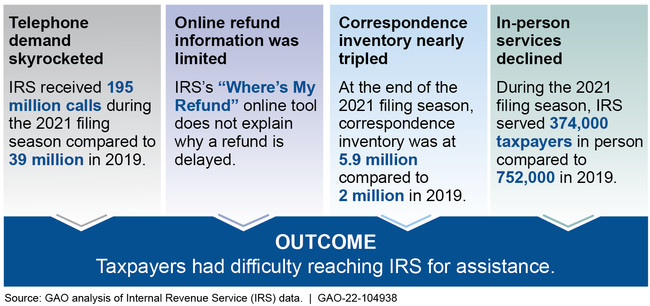IRS faced an unprecedented workload during the 2021 filing season. It began with a backlog of 8 million returns from the prior year. IRS reduced the backlog, but still had millions of new 2021 returns to process by year's end. Taxpayers faced refund delays due to an unprecedented volume of returns requiring manual review — most with similar tax credit errors.
During the 2021 filing season, taxpayers also struggled to get help from IRS as:
- Telephone demand skyrocketed
- Online refund information was scant
- Correspondence nearly tripled
- In-person service declined
We recommended that IRS address these issues.
During the 2021 filing season, taxpayers also struggled to get help from IRS as:
- Telephone demand skyrocketed
- Online refund information was scant
- Correspondence nearly tripled
- In-person service declined
We recommended that IRS address these issues.

What GAO Found
The Internal Revenue Service (IRS) experienced multiple challenges during the 2021 filing season as it struggled to respond to an unprecedented workload that included delivering COVID-19 relief. IRS began the filing season with a backlog of 8 million individual and business returns from the prior year that it processed alongside incoming returns. IRS reduced the backlog of prior year returns, but as of late December 2021, had about 10.5 million returns to process from 2021. Further, IRS suspended and reviewed 35 million returns with errors primarily due to new or modified tax credits. As a result, millions of taxpayers experienced long delays in receiving refunds. GAO found that some categories of errors occur each year; however, IRS does not assess the underlying causes of taxpayer errors on returns. Doing so could help reduce future errors, refund delays, and strains on IRS resources.
IRS has paid nearly $14 billion in refund interest in the last 7 fiscal years, with $3.3 billion paid in fiscal year 2021. Using IRS data, GAO identified some characteristics of refund interest payments, such as amended returns. However, IRS does not identify, monitor, and mitigate issues contributing to refund interest payments. Accordingly, IRS is missing an opportunity to reduce costs.
Challenges with IRS Customer Service during the 2021 Filing Season

IRS answered more phone calls than in prior years, but taxpayers had a difficult time reaching IRS due to high call volumes. IRS urged taxpayers to access its “Where's My Refund” online tool to get refund status information; yet this tool provides limited information on refund status and delays. IRS does not have plans to modernize “Where's My Refund,” although this could help IRS better serve taxpayers, lower call volume, and reduce costs. IRS's correspondence inventory was 5.9 million by the end of the filing season, and grew to more than 8 million by the start of 2022. IRS does not have a plan or estimates for reducing this backlog; doing so could help reduce demands on IRS. Finally, in-person service has significantly declined since 2015 and IRS has not fully considered alternatives for its current in-person service model. IRS's plans to improve the taxpayer experience—such as by expanding virtual services—may further contribute to the decline in in-person visits.






